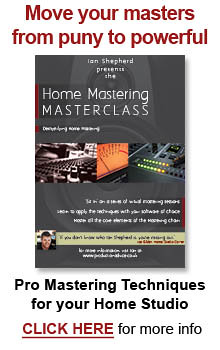

Mastering is simple. Not easy, but simple.
That's the message behind this series of 6 video tutorials I made recently for Sound On Sound magazine.
In them, I walk you through my entire mastering process from beginning to end, explaining how and why I work the way that I do at every stage.
(more…)Everyone is talking about AI, especially in mastering.
And there are certainly some exciting developments and interesting new products.
But can AI really take the place of a human engineer ?
I recently had the chance to test this idea for myself, using an actual mastering project, and in the video above I show you what I found, and the conclusions I drew from it.
Take a look, the results may surprise you !
I just watched an interesting video that Drew Oliver made for iZotope, where he notices a "peak level bump" in a recent release, and suggests it might be a deliberate production strategy.
And maybe he's right, but I assumed something very different when I saw what he was talking about – and in fact I can think of several other possible explanations, too.
I thought you might be interested, so I made a video explaining my thoughts. Take a look and let me know what you think ! And be sure to check out the original video - the section I'm commenting on starts @ 12:31
Almost 30 years ago (!) I mastered what I believe was the second ever album of 'generative music' to be released.
Around the same time, inspired by the experience, I bought the first – Brian Eno's 'Generative Music 1' – but was never able to play it properly.
...until now.
This is the (deeply nerdy) story of those two albums, of why I love them both, and how I finally managed to listen to Brian Eno's 'Generative Music 1' myself, exactly as it was originally intended.
(more…)Have you watched one of my videos recently and thought something like "this is all very interesting, but I'm not sure I can hear what you're talking about" ?
If so, then YouTube's new Stable Volume feature could be the reason.
In this video I show how it works, and how to disable it. Because when it's on, you'll never hear my videos the way I intended them 😕
I also explain why YouTube have added Stable Volume, and why it's not a complete disaster for everything we watch - but also why I'd like to be able to disable it permanently for my channel.

